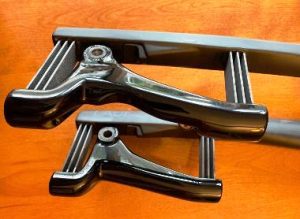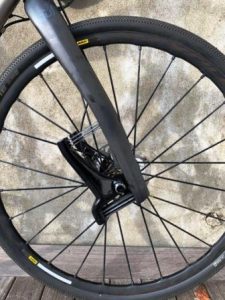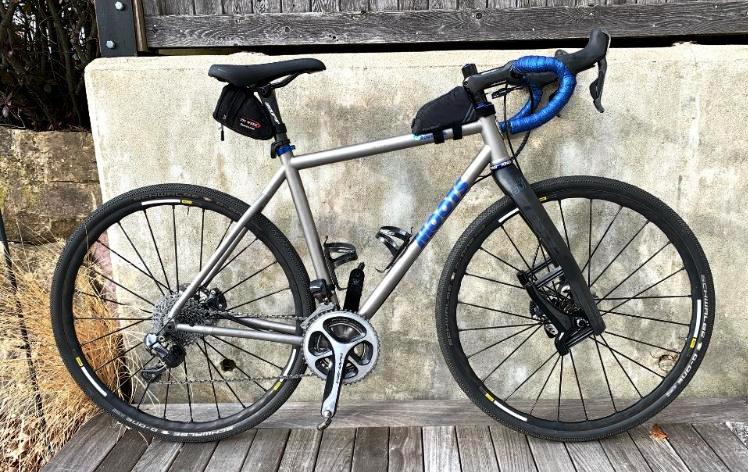Lauf Grit and Lauf Grit SL Review
From bikes like Niner’s MCR and Moots Routt YBB to Lauf’s Grit forks, suspension is an emerging trend in gravel road bikes. Gravel roads can often be rough on their own and going off-road on your adventure bike means encountering even more jostling. Suspension on a gravel bike makes sense for many riders. One of the more unconventional suspension offerings is the Lauf Grit fork. Conceived about ten years ago, the Grit is a monocoque carbon fiber design that promises the benefits of adequate travel and strong compliance in a lightweight and laterally stiff package. How does it deliver? Read on…
The Lauf Grit Fork Concept
The Lauf is unlike all other suspension forks that I know. The front wheel mounts to a sub-assembly attached to the fork legs by four sets (two on each fork leg) of flexible, glass fiber leaf springs (see pictures). 
Made of what is termed “S-2 glass fiber”, the glass fiber is stronger, stiffer and more durable than other types of glass fiber. It also holds its strength after repeated flexing, so the springs do not weaken with use as may happen with metal springs. While carbon fiber springs are used effectively in some bike applications (many Look clipless pedals come to mind), in this application glass fiber is better than carbon fiber because it is not as rigid. The fiber is designed to continually flex hundreds or thousands of times every ride.
Lauf Grit Fork Simplicity
The Lauf Fork uses maintenance-free glass fiber leaf springs to absorb shock and impact. There are no parts to wear out. No seals or oil to replace, no air pressure to adjust, no periodic rebuild every 50 hours – nothing. The lack of normal shock absorber moving parts eliminates friction, stiction and significantly reduces weight over normal suspension forks. However, this simplicity also means that there are no compression or rebound adjustments and no ability to tune shock performance to your particular taste. This being said, for me, the progressive stiffness of the springs, their fast reaction, and the limited travel eliminates the need for these adjustments.
Lauf Grit Fork Travel
The Grit has 30mm of travel. While this would be a piddling amount for mountain bikes, for gravel and dirt roads it sounds like just enough travel to take the edge off rough surfaces effectively.
Lauf Suspension Fork Models
Lauf makes four suspension forks: two for gravel roads, one for fat bikes, and one for mountain bikes. They also make one carbon road fork without any suspension. The two gravel forks are the Grit and the Grit SL. The SL weighs 850 grams, 50 grams lighter than the standard Grit. Beyond an aesthetic difference, the SL has an integrated crown race to fit a 1.5” 45-degree headset bearing, while the Grit does not. The tapered steerer tube diameter for both is 1.125” top and 1.5” bottom.
Grit and the Grit SL. The SL weighs 850 grams, 50 grams lighter than the standard Grit. Beyond an aesthetic difference, the SL has an integrated crown race to fit a 1.5” 45-degree headset bearing, while the Grit does not. The tapered steerer tube diameter for both is 1.125” top and 1.5” bottom.
At the time of writing, pricing for the Lauf Grit is $790, and for the Grit SL $990. Not inexpensive, but competitive with many other high quality conventional suspension forks, and cheaper than some. For comparison purposes, the Fox 32 AX gravel fork, offering 40mm of travel, retails for $829, and weighs 1,439 grams – 1.3 pounds more than the Grit SL. A Suntour GVX gravel fork, with up to 60mm of travel, only costs $500, but weighs in at 1,725 grams – over twice the weight of the Grit SL!
Lauf Fork Axle and Geometry Specs
Lauf forks can accommodate either 12mm or 15mm thru axles, to be specified when the fork is ordered. The forks are designed to accommodate a 160mm front brake rotor with a flat mount caliper, so a 140mm rotor will not work. But then, very few riders use a 140mm rotor on the front brake of a gravel bike. The fork comes with a front thru axle that you will probably have to use as the thru axle on most front forks will not be long enough.
The geometry of the fork is such that, when being ridden, it will have the steering characteristics of a fork with 45mm rake and 395mm axle to crown length. This matches the geometry of the fork that came on my wife’s bike quite well. Maximum rider weight on a Lauf Grit is 242 lbs, or 110 kg.
Finally, for those of you doing bikepacking with your gravel bike, be forewarned that there are no cargo mounts on the Lauf Grit or Grit SL forks.
Lauf Grit Aesthetics
So much for the technical side of things. How about aesthetics? Well, as the old saying goes, “beauty is in the eye of the beholder”. But another adage is that “form follows function”. The Lauf fork’s appearance may take a bit of getting used to for some. It is not ugly, at least not to me. It is just very different from just about anything else I have seen. It did not take me long to decide that, while it is not svelte like the fork it replaced, both my wife and I think it looks fine.
Lauf Grit Compatibility
My wife was having problems with hand pain, due to the tension she holds in her arms and shoulders over rough surfaces. We decided to try the Lauf Grit SL fork on her gravel bike. Before ordering the Grit SL I contacted both Moots, the manufacturer of her bike, and Lauf to be sure that neither saw any problems using the fork with a Moots Routt. Both manufacturers said it would be a great match, the Moots representative saying that he uses a Lauf fork on his Moots mountain bike.
Included with the fork are a 1.5” headset bearing for use where the bearing seat is integrated into the frame’s headtube, steerer tube expander plug and top cap, front thru axle, brake hose clips, and three zip ties.
Lauf Fork Installation
The installation did not present any untoward problems. I installed the fork myself, having done such a job times beyond count. I did have to replace the hydraulic brake hose for the front brake, as it was now too short after having been removed from the Moots fork. Having a bleed kit and a lot of experience with it, this was a mild nuisance, but not a big deal. The brake hose on the Lauf Grit SL does not run internally, so the installation is not quite as neat as the internal routing on the Moots fork. On the other hand external routing made installation easier. The fork comes with two clips to secure the brake hose to mounts on the left fork leg, or you can use the zip ties that are included.
In my opinion the installation of a fork is not a DIY project for most riders. There are simply too many things that can be done wrong that could compromise the safety of the bike. For example, as mentioned previously, you need to be sure that the bottom headset bearing is the correct size and angle. Headsets sometimes need to be replaced when installing a new fork, possibly requiring specialized tools. Another common item that has to be done when replacing a fork is redoing the front brake hose – which is not particularly straightforward on today’s hydraulic disc brake systems. Leaving this job to professionals, like the mechanics at Fit Werx, who do installs like this daily, could save a number of headaches.
Lauf Grit Fork Performance
So, how does the Lauf Grit fork perform in the real world? Very nicely, I must say.
I was initially concerned about how the stiff springs would work with a 120-pound rider. Would they be too stiff to effectively absorb shock? When I asked Lauf about this I was assured that, while there would be less sag, the shock and vibration absorption characteristics of the fork would be just as effective for a light rider as a larger rider. The fork does indeed soak up the type of bumps to be found on all but the roughest dirt and gravel roads. It may not be quite enough for what in Vermont we term Class 4 roads, or serious off-road excursions on terrain perhaps better suited to a mountain bike, but for any half-decently maintained gravel road, and for many cross-country-type off-road forays, it works great.
The springs react very quickly to high frequency, small amplitude bumps, both on compression and rebound, so the lack of adjustment is not an issue. Steering, while perhaps not quite as quick and precise as with the lighter Moots fork, is excellent. The front wheel rolls over obstacles with ease, and the quick rebound on the suspension means the wheel maintains better contact with the ground, resulting in greater stability and likely lower rolling friction. Performance on washboard surfaces is excellent. Even under braking, the Lauf Grit increases comfort and control and therefore improves safety.
When I test-rode the bike I did experience some very slight bobbing of the front when climbing out of the saddle. My wife almost never stands up, and at 120 lbs. it would not be a problem even if she did. I weigh 50 pounds more, and do get out of the saddle on occasion, so some slight bobbing was expected. It is worth noting that this was only noticeable for me because I was looking for it. This would also happen with a conventional telescopic fork, requiring the rider to lock out the shock to eliminate it. Related, I noticed slight front-end sag when I got on the bike, but this is to be expected and would be present with a telescopic shock fork as well.
Did the Lauf Fork Solve Hand Pain?
The Lauf Grit SL has helped my wife’s hand pain a great deal. This is due to two reasons – 1) Shock absorbtion 2) Less nervous tension on rough surfaces. The fork has made a big difference in her riding comfort and confidence on rough surfaces. Simply stated, she likes it very much.
Lauf Grit Fork Conclusions
As I have written before, the Moots Routt RSL is an amazing bicycle. The ride is buttery smooth, while also delivering precise handling and outstanding power delivery. The Lauf Grit SL fork is a wonderful compliment to the inherent shock absorbing qualities of the titanium Routt, making the bike even more comfortable, and controllable. The bottom line is that my wife really likes how the Lauf fork works. Installing the Lauf Grit SL on her bike achieved our goals.
If you are looking to upgrade your existing gravel adventure bike with some front suspension, or are spec’ing a new gravel bike purchase, the Lauf Grit or the Grit SL are well worth consideration.
Contact any of the three Fit Werx shops if you have questions about whether the Lauf Grit will work on your bike.

